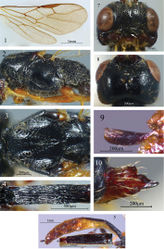Coeliniaspis insularis
| Notice: | This page is derived from the original publication listed below, whose author(s) should always be credited. Further contributors may edit and improve the content of this page and, consequently, need to be credited as well (see page history). Any assessment of factual correctness requires a careful review of the original article as well as of subsequent contributions.
If you are uncertain whether your planned contribution is correct or not, we suggest that you use the associated discussion page instead of editing the page directly. This page should be cited as follows (rationale):
Citation formats to copy and paste
BibTeX: @article{Zheng2017JournalofHymenopteraResearch, RIS/ Endnote: TY - JOUR Wikipedia/ Citizendium: <ref name="Zheng2017Journal of Hymenoptera Research">{{Citation See also the citation download page at the journal. |
Ordo: Hymenoptera
Familia: Braconidae
Genus: Coeliniaspis
Name
Coeliniaspis insularis (Tobias, 1998) comb. n. – Wikispecies link – Pensoft Profile
- Coelinius (Sarops) insularis Tobias, 1998: 308–309.
- Sarops insularis; Fischer, 2001: 45–47 (redescription).
Description
Female (from Mt. Wuyi): Body length 7.5 mm; fore wing length 4.0 mm.
Head. Antenna with 49 segments present and apical part missing, according to original description with 46–56 segments. First flagellomere 1.1 times as long as second flagellomere, second flagellomere as long as third flagellomere. First and second flagellomeres 1.8 and 1.7 times as long as their maximum width, respectively. Head in dorsal view subquadrate, 1.4 times as wide as its median length. Eye 1.1 times as long as temple (Fig. 8). OOL:OD:POL = 21:8:6. Mandible with 4 teeth, tooth somewhat curved outwards. Additional tooth between first tooth and middle tooth on base of middle tooth. Middle tooth acute and long, other teeth obtuse and shorter (Fig. 10). Face somewhat protruding, strongly punctate, conspicuously setose, with a weak medio-longitudinal crest on its lower half and a depressed medio-dorsally (Fig. 7). Frons setose, somewhat depressed and rugulose medio-anteriorly (Fig. 8). Clypeus slightly convex dorsally, hardly protruding beyond face in lateral view and medio-ventrally distinctly depressed and without ventral lobes (Fig. 7).
Mesosoma. Length of mesosoma 2.3 times its height. Pronotum with a deep and nearly round pronope (Fig. 8), side of pronotum moderately punctate (Fig. 2). Propleuron largely crenulate-rugose. Mesoscutum conspicuously setose (Figs 2, 3). Notauli complete, wide posteriorly and strongly crenulate. Medio-posterior depression at posterior half of mesoscutum narrow, deep and crenulate (Fig. 3). Scutellar sulcus deep and distinctly crenulate. Scutellum somewhat convex, densely setose. Metanotum with a relatively weak median spine, not protruding beyond scutellum. Propodeum relatively long, largely reticulate-rugose and sparsely setose, medio-longitudinal carina restricted to anterior fifth of propodeum. Mesopleuron mainly glabrous and smooth. Precoxal sulcus long, almost transverse and nearly complete, rugulose (Fig. 2). Mesopleural furrow relatively narrow, curved and evenly crenulate. Metapleuron mainly reticulate-rugose and sparsely setose (Fig. 2).
Wings. Fore wing: pterostigma ellipitical, 0.8 times as long as vein 1-R1; vein r arises from middle of pterostigma; vein r:3-SR+SR1:2-SR = 10:64:21; vein 1-SR+M nearly straight; vein 3-SR+SR1 distinctly sinuate (Fig. 1); vein cu-a postfurcal, almost perpendicular to vein 2-CU1 and 2-1A; vein 1-CU1:2-CU1 = 1:7; first subdiscal cell more or less elongate. Hind wing: 1-1A distinctly curved (Fig. 1); vein M+CU:1-M = 3:2.
Legs. Hind femur 4.0 times as long as wide. Hind tibia as long as its tarsus. Outer and inner hind tibial spurs 0.2 and 0.3 times as long as basitarsus, respectively. Hind basitarsus 2.0 times as long as second tarsal segment. Hind telotarsus 0.8 times as long as third tarsal segment.
Metasoma. Tergites very elongate (Figs 4–6). First tergite 4.0 times as long as its maximum width (5.0 times its apical width), parallel-sided, coarsely longitudinally striate and sparsely setose (Fig. 4). Dorsope relatively large and deep (Fig. 4). Laterope large and finely rugose. Second tergite narrow rectangular and with coarse longitudinal striae, 0.85 times as long as first tergite, and its apical half gradually narrowed posteriorly in dorsal view (Fig. 6), its apical width 0.6 times its basal width, largely glabrous and 6.1 times longer than its apical width. Third and following tergites blade-like compressed (Fig. 5), third tergite smooth and setose. Ovipositor widened and distinctly projecting beyond apex of metasoma (Fig. 9), its setose part 0.2 times as long as first tergite.
Colour. Black. Antenna dark reddish brown. Clypeus black, labrum reddish brown, palpi yellow, mandible reddish brown but edge of teeth black. Pterostigma and most veins of hind wing yellowish brown. Fore and middle legs mainly brownish yellow, hind leg dark reddish brown but trochanter brownish yellow. First and second tergites mainly black, third and following tergites yellowish brown, ovipositor sheath largely dark brown (Fig. 9).
Male. Similar to female, but body 7.0 mm long, antenna with 69 segments and head, in dorsal view, 1.4 times as wide as its median length. According to the original description, antenna of paratype male with 59 segments.
Biology
Unknown.
Material examined
1 ♀, China, Fujian, Mt. Wuyi, 3.VII.1981, leg. Yihua Liu; 1 ♂, same data but leg. Juchang Huang.
Distribution
Known only from the type locality in Far East Russia (Sakhalin Obl.) and from China (Fujian). The species and genus are new for China.
Taxon Treatment
- Zheng, M; Chen, J; Achterberg, C; 2017: First report of the genus Coeliniaspis Fischer (Hymenoptera, Braconidae, Alysiinae) from China and Russia Journal of Hymenoptera Research, (57): 135-142. doi
Images
|
